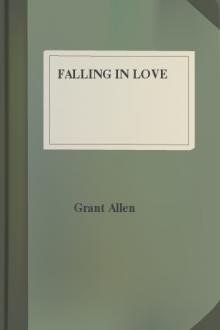Falling in Love by Grant Allen (different e readers .txt) 📕

- Author: Grant Allen
- Performer: -
Book online «Falling in Love by Grant Allen (different e readers .txt) 📕». Author Grant Allen
Even since the insulation of Britain a great many new plants and animals have been added to our population, both by human design and in several other casual fashions. The fallow deer is said to have been introduced by the Romans, and domesticated ever since in the successive parks of Celt and Saxon, Dane and Norman. The edible snail, still scattered thinly over our southern downs, and abundant at Box Hill and a few other spots in Surrey or Sussex, was brought over, they tell us, by the same luxurious Italian epicures, and is even now confined, imaginative naturalists declare, to the immediate neighbourhood of Roman stations. The mediæval monks, in like manner, introduced the carp for their Friday dinners. One of our commonest river mussels at the present day did not exist in England at all a century ago, but was ferried hither from the Volga, clinging to the bottoms of vessels from the Black Sea, and has now spread itself through all our brooks and streams to the very heart and centre of England. Thus, from day to day, as in society at large, new introductions constantly take place, and old friends die out for ever. The brown rat replaces the old English black rat; strange weeds kill off the weeds of ancient days; fresh flies and grubs and beetles crop up, and disturb the primitive entomological balance. The bustard is gone from Salisbury Plain; the fenland butterflies have disappeared with the drainage of the fens. In their place the red-legged partridge invades Norfolk; the American black bass is making himself quite at home, with Yankee assurance, in our sluggish rivers; and the spoonbill is nesting of its own accord among the warmer corners of the Sussex downs.
In the plant world, substitution often takes place far more rapidly. I doubt whether the stinging nettle, which renders picnicking a nuisance in England, is truly indigenous; certainly the two worst kinds, the smaller nettle and the Roman nettle, are quite recent denizens, never straying, even at the present day, far from the precincts of farmyards and villages. The shepherd's-purse and many other common garden weeds of cultivation are of Eastern origin, and came to us at first with the seed-corn and the peas from the Mediterranean region. Corn-cockles and corn-flowers are equally foreign and equally artificial; even the scarlet poppy, seldom found except in wheat-fields or around waste places in villages, has probably followed the course of tillage from some remote and ancient Eastern origin. There is a pretty blue veronica which was unknown in England some thirty years since, but which then began to spread in gardens, and is now one of the commonest and most troublesome weeds throughout the whole country. Other familiar wild plants have first been brought over as garden flowers. There is the wall-flower, for instance, now escaped from cultivation in every part of Britain, and mantling with its yellow bunches both old churches and houses and also the crannies of the limestone cliffs around half the shores of England. The common stock has similarly overrun the sea-front of the Isle of Wight; the monkey-plant, originally a Chilian flower, has run wild in many boggy spots in England and Wales; and a North American balsam, seldom cultivated even in cottage gardens, has managed to establish itself in profuse abundance along the banks of the Wey about Guildford and Godalming. One little garden linaria, at first employed as an ornament for hanging-baskets, has become so common on old walls and banks as to be now considered a mere weed, and exterminated accordingly by fashionable gardeners. Such are the unaccountable reverses of fortune, that one age will pay fifty guineas a bulb for a plant which the next age grubs up unanimously as a vulgar intruder. White of Selborne noticed with delight in his own kitchen that rare insect, the Oriental cockroach, lately imported; and Mr. Brewer observed with joy in his garden at Reigate the blue Buxbaum speedwell, which is now the acknowledged and hated pest of the Surrey agriculturist.
The history of some of these waifs and strays which go to make up the wider population of Britain is indeed sufficiently remarkable. Like all islands, England has a fragmentary fauna and flora, whose members have often drifted towards it in the most wonderful and varied manner. Sometimes they bear witness to ancient land connections, as in the case of the spotted Portuguese slug which Professor Allman found calmly disporting itself on the basking cliffs in the Killarney district. In former days, when Spain and Ireland joined hands in the middle of the Bay of Biscay, the ancestors of this placid Lusitanian mollusk must have ranged (good word to apply to slugs) from the groves of Cintra to the Cove of Cork. But, as time rolled on, the cruel crawling sea rolled on also, and cut away all the western world from the foot of the Asturias to Macgillicuddy's Reeks. So the spotted slug continued to survive in two distinct and divided bodies, a large one in South-western Europe, and a small isolated colony, all alone by itself, around the Kerry mountains and the Lakes of Killarney. At other times pure accident accounts for the presence of a particular species in the mainlands of Britain. For example, the Bermuda grass-lily, a common American plant, is known in a wild state nowhere in Europe save at a place called Woodford, in county Galway. Nobody ever planted it there; it has simply sprung up from some single seed, carried over, perhaps, on the feet of a bird, or cast ashore by the Gulf Stream on the hospitable coast of Western Ireland. Yet there it has flourished and thriven ever since, a naturalised British subject of undoubted origin, without ever spreading to north or south above a few miles from its adopted habitat.
There are several of these unconscious American importations in various parts of Britain, some of them, no doubt, brought over with seed-corn or among the straw of packing-cases, but others unconnected in any way with human agency, and owing their presence here to natural causes. That pretty little Yankee weed, the claytonia, now common in parts of Lancashire and Oxfordshire, first made its appearance amongst us, I believe, by its seeds being accidentally included with the sawdust in which Wenham Lake ice is packed for transport. The Canadian river-weed is known first to have escaped from the botanical gardens at Cambridge, whence it spread rapidly through the congenial dykes and sluices of the fen country, and so into the entire navigable network of the Midland counties. But there are other aliens of older settlement amongst us, aliens of American origin which nevertheless arrived in Britain, in all probability, long before Columbus ever set foot on the low basking sandbank of Cat Island. Such is the jointed pond-sedge of the Hebrides, a water-weed found abundantly in the lakes and tarns of the Isle of Skye, Mull and Coll, and the west coast of Ireland, but occurring nowhere else throughout the whole expanse of Europe or Asia. How did it get there? Clearly its seeds were either washed by the waves or carried by birds, and thus deposited on the nearest European shores to America. But if Mr. Alfred Russel Wallace had been alive in pre-Columban days (which, as Euclid remarks, is absurd), he would readily have inferred, from the frequent occurrence of such unknown plants along the western verge of Britain, that a great continent lay unexplored to the westward, and would promptly have proceeded to discover and annex it. As Mr. Wallace was not yet born, however, Columbus took a mean advantage over him, and discovered it first by mere right of primogeniture.
In other cases, the circumstances under which a particular plant appears in England are often very suspicious. Take the instance of the belladonna, or deadly nightshade, an extremely rare British species, found only in the immediate neighbourhood of old castles and monastic buildings. Belladonna, of course, is a deadly poison, and was much used in the half-magical, half-criminal sorceries of the Middle Ages. Did you wish to remove a troublesome rival or an elder brother, you treated him to a dose of deadly nightshade. Yet why should it, in company with many other poisonous exotics, be found so frequently around the ruins of monasteries? Did the holy fathers—but no, the thought is too irreverent. Let us keep our illusions, and forget the friar and the apothecary in 'Romeo and Juliet.'
Belladonna has never fairly taken root in English soil. It remains, like the Roman snail and the Portuguese slug, a mere casual straggler about its ancient haunts. But there are other plants which have fairly established their claim to be considered as native-born Britons, though they came to us at first as aliens and colonists from foreign parts. Such, to take a single case, is the history of the common alexanders, now a familiar weed around villages and farmyards, but only introduced into England as a pot-herb about the eighth or ninth century. It was long grown in cottage gardens for table purposes, but has for ages been superseded in that way by celery. Nevertheless, it continues to grow all about our lanes and hedges, side by side with another quaintly-named plant, bishop-weed or gout-weed, whose very titles in themselves bear curious witness to its original uses in this isle of Britain. I don't know why, but it is an historical fact that the early prelates of the English Church, saintly or otherwise, were peculiarly liable to that very episcopal disease, the gout. Whether their frequent fasting produced this effect; whether, as they themselves piously alleged, it was due to constant kneeling on the cold stones of churches; or whether, as their enemies rather insinuated, it was due in greater measure to the excellent wines presented to them by their Italian confrères, is a minute question to be decided by Mr. Freeman, not by the present humble inquirer. But the fact remains that bishops and gout got indelibly associated in the public mind; that the episcopal toes were looked upon as especially subject to that insidious disease up to the very end of the last century; and that they do say the bishops even now—but I refrain from the commission of scandalum magnatum. Anyhow, this particular weed was held to be a specific for the bishop's evil; and, being introduced and cultivated for the purpose, it came to be known indifferently to herbalists as bishop-weed and gout-weed. It has now long since ceased to be a recognised member of the British Pharmacopœia, but, having overrun our lanes and thickets in its flush period, it remains to this day a visible botanical and etymological memento of the past twinges of episcopal remorse.
Taken as a whole, one may fairly say that the total population of the British Isles consists mainly of three great elements. The first and oldest—the only one with any real claim to be considered as truly native—is the cold Northern, Alpine and Arctic element, comprising such animals as the white hare of Scotland, the ptarmigan, the pine marten, and the capercailzie—the last once extinct, and now reintroduced into the Highlands as a game bird. This very ancient fauna and flora, left behind soon after the Glacial Epoch, and perhaps in part a relic of the type which still struggled on in favoured spots during that terrible period of universal ice and snow, now survives for the most part only in the extreme north and on the highest and chilliest mountain-tops, where it has gradually been driven, like tourists in August, by the increasing warmth and sultriness of the southern lowlands. The summits of the principal Scotch hills are occupied by many Arctic plants, now slowly dying out, but lingering yet as last relics of that old native British flora. The Alpine





Comments (0)